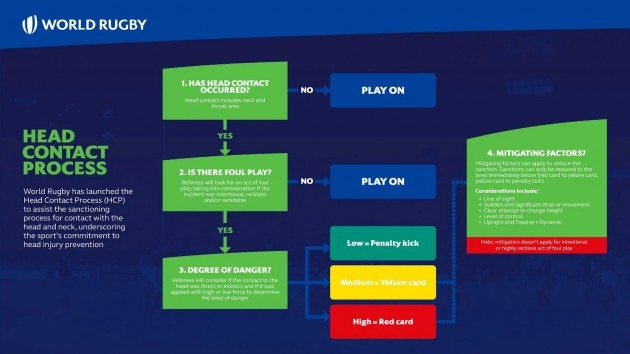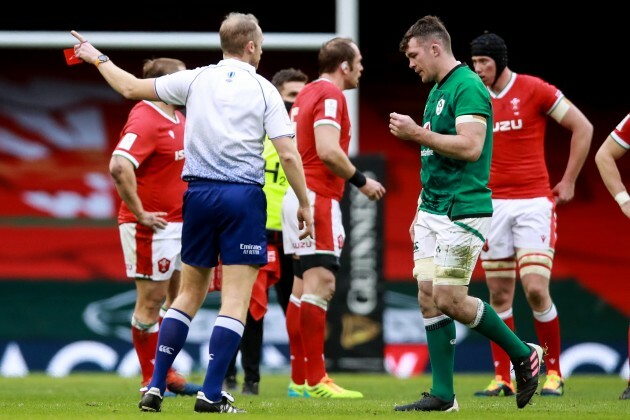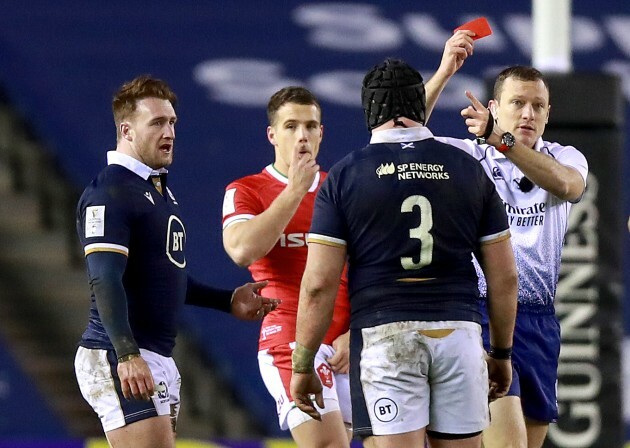IT DIDN’T GET much attention – this kind of thing never really does – but World Rugby publicly launched its new ‘Head Contact Process‘ this week.
It’s an evolution of the High Tackle Framework that made some headlines in the lead-up to the 2019 World Cup, with this update intended to help match officials make decisions around sanctions for any contact with the head, not just in high tackles and shoulder charges.
The new process also covers dangerous clearouts, head-to-head collisions, and leading elbows/forearms.
While us mugs in the public only found out about it this week, World Rugby says the Head Contact Process [HPC] has already been in use in the current Six Nations and “across elite competitions around the world” but will now come into effect immediately at all other levels of the game.
Joe Schmidt, now with a big influence on all things related to refereeing and laws in his role as World Rugby’s director of rugby, says the HPC “will be regularly reviewed with the ambition to ensure it continues to reflect and support the current playing landscape.”
While some instances of foul play involving clear head contact are still being missed, no one will have failed to notice the recent spate of red and yellow cards in the Six Nations, Premiership, Pro14, and beyond in this area.
Red cards have played a major role in the Six Nations so far, with Ireland and Scotland both losing to Wales after having players sent off for making head contact with an opponent while attempting to clear out a ruck.
The new HPC has reiterated World Rugby’s intense desire to see contact with the head reduced amidst the threat of a concussion lawsuit from former professional players.
At the same time, the HPC does appear to leave referees with a little more flexibility within a fairly simplified process of assessing whether players deserve red, yellow, a penalty only, or no sanction at all. It is certainly worthwhile reading through World Rugby’s rundown and watching the videos to understand this law application guideline.
More than ever, the onus is on the players to be squeaky clean with their intent and technique.
“We’re conscious of the trend over the last two or three weeks where there have been more cards given than ever before,” said Scotland boss Gregor Townsend yesterday.
Townsend was part of the World Rugby review group that examined the previous High Tackle Framework and helped to morph it into the wider-ranging but refined HPC. Theat group also included the likes of Schmidt, Wayne Barnes, ex-All Black Conrad Smith, professor Ross Tucker, and Australia boss Dave Rennie.
Having seen his side suffering after a red card to Zander Fagerson against Wales – a sending off the Scots subsequently contested on appeal – Townsend knows how difficult it is for players currently as they still aim to bring aggression to the game.
Ireland’s Peter O’Mahony was also sent off for making contact with the head of an opponent in Ireland’s defeat to Wales, underlining that the clearout is an area of particular focus.
“It’s very tricky because it’s the one area in the game where you have to be aggressive, especially when people are contesting for the ball and there’s a likelihood that you are going to connect with the upper body of that player if their head is close to the ground,” says Townsend.
“It’s different from the high tackle because in that case, you make a conscious decision to go to a height which puts you in trouble.
“Whereas when you are clearing contact you have to be low, aggressive, and quick, so we’ve got to make sure that we are showing proper technique and that we’re winning races before the jackler has a chance to get on the ball.
“If you lose a race then you are likely to be coming in with more pace and the jackler is maybe latched onto the ball, so it is a tricky area and we’ve seen more cards given.
“Zander’s one was very rare for us. Our contact work has been excellent in the first two games, as has Ireland’s.
“So, we just have to focus on what we do in training and not move away from that – as long as the players’ technique is right when we go into contact.”
Ireland boss Andy Farrell pointed out that all teams were been informed of the key refereeing focuses before the Six Nations, with head contact, the offside line, and players chasing the ball from in front of the kicker among them.
Andrew Brace was in Ireland camp for training this week and Farrell has brought in an Irish referee every week during the Six Nations in their bid to be as disciplined as possible. Romain Poite is in charge of tomorrow’s clash with the Scots and could have a big say in deciding the outcome.
Ireland paid the price for O’Mahony’s clearout against Wales, but Farrell feels his players have adapted well overall in finding a balance between bringing aggression and staying on the right side of the law.
“It is tough,” said Farrell. “You’ve got to be accurate, haven’t you? You’ve got to be accurate in what you do but our players are pretty adaptable to that as well.”



